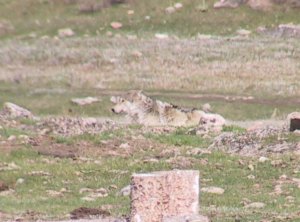Wildlife services has killed five wolves in the past 2 days in Montana. The language of the article is interesting to note . 5 wolves for 2 calves, four were gunned down from a helicopter.
– – – –
Update from RM Sept. 29. Ed Bangs has sent out the Grey Wolf Recovery Weekly Progress Report from USFWS, and there are more new “controls” in Montana. Bangs writes:
On the 20th, MT WS and CSKT confirmed that wolves had killed a steer calf near Ravalli, MT. Wolves were heard howling immediately above kill site and on the 21st the collared female was located immediately above kill site within a 1/2 mile. Control to remove the remainder of this pack is ongoing. On the 25th, MT WS shot 4 of 5 members of the Hewolf Mountain Pack from a helicopter. Three animals were recovered but the fourth wasn’t found. The remaining radio-collared female will be removed at a later date.
On Sept. 24th, MT WS used a helicopter to shoot 4 wolves from the Sapphire pack southwest of Philipsburg, MT in response to a confirmed calf depredation on the 21st. An adult female and 3 female pups were removed near the ranch where the depredation occurred. Up to 11 wolves remain in the pack. Control is now finished.
On Sept 24th, MT WS killed the collared adult female in the Fleecer Mtn pack, completing the removal of this pack. A 4th uncollared gray wolf either dispersed or was killed unknowingly last week during control operations. The SOS permit issued to the affected landowner was cancelled.
On Sept. 25th, MT WS used a helicopter to shoot the collared alpha female of the depredating Bearmouth pack, completing the removal of the pack.
A yellow lab was reported killed on private land in the Ninemile Valley, MT on the 26th. MFWP investigated and confirmed wolves had killed the dog. The incident occurred around 8 am in a small field about 80 yards from the house. The Ninemile pack consists of at least 4 adult wolves and 2 pups and is currently uncollared.
– – – –
I should add that the Ninemile Pack isn’t just any old wolf pack, but the oldest pack in the Northern Rockies, originated from native wolves that migrated down from Canada into NW Montana and eventually the Ninemile Valley. RM









 Benjamin Tuggle, Southwest regional director of U.S. Fish & Wildlife Service (FWS) has published an Op-Ed in the Arizona Republic:
Benjamin Tuggle, Southwest regional director of U.S. Fish & Wildlife Service (FWS) has published an Op-Ed in the Arizona Republic: 